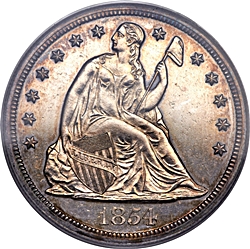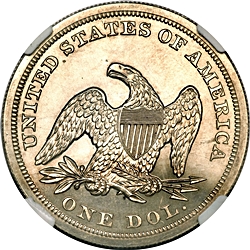 |
1854 
 |
 |
General CommentsAs with most of the dollars of the era those dated 1854 didn’t circulate freely in commerce. They were used primarily for trade with foreign countries, in particular China. Only California was interested in silver dollars for circulation. According to Walter Breen (Reference 20, page 439) about 10,000 were shipped to California for use as in commerce. California, in 1854, was NOT a mecca of coin collecting, so it’s safe to assume that many of these coins were lost or melted over the ensuing years. This is a key date in the Liberty Seated dollar series. Most would consider 1854 dollars as rare, though by Liberty Seated dollar standards they’re only scarce. Although the date is overshadowed by its near neighbors, the 1851 and 1852, it would be a key in almost any other series. As with almost all dates in the 1850’s the mintage isn’t a good indication of its rarity. With a mintage ranking of 21st out of 47 the collector would expect that it would be easy to locate, but that’s usually not the case. Business strike examples can be found with patient searching, but aren’t readily available. Mint state examples are truly rare. The finest known business strike is a single MS66 graded by PCGS. They have graded two additional coins MS65. NGC has graded 6 in that grade. It’s probable that those 8 documented MS65 examples represent at most 4 or 5 coins. A total of nine coins have been graded MS64, seven by PCGS, two by NGC. One of the PCGS coins was graded MS64+. Twelve have been graded MS63, six each by PCGS and NGC. A total of 47 coins have been graded at all levels of mint state by the two major services. The true rarities are the lower grade examples. Neither grading service has encapsulated a coin graded less the VF30. Only 9 coins have been graded less than XF40. If you’re trying to put together a F/VF set you may have to find a currently ungraded example, settle for a coin with issues, or make an exception and include a coin that’s at least XF in your set. Population statistics are as of January, 2019. |
|
The finest known proof is a single PR66 graded by NGC. NGC has graded eight coins PR64. Two of the eight were graded PR64+. One of these was rated as cameo with a star designation, the other ultra cameo. NGC graded seven additional coins PR63. The highest graded PCGS coins are three PR65 cameo examples. They’ve graded seven more at the PR64 level and ten at PR63. The two services combined have graded 42 coins, all rated as PR60 or higher. Several of these are surely re-submissions. Population statistics are as of January, 2019.
1854 business strike examples are found with strikes that vary from good to very sharp. Star centrals and hair detail are generally well defined. Some examples show slight weakness on the eagle’s leg feathers, but fully struck examples can be found with patient searching. High-grade business strikes are sometimes semi-prooflike, but more often frosty. Fully prooflike business strikes are rare.
1854 Proofs
Estimates of the proof mintage vary from 50 to 150. The literature has always been controversial on this subject, with widely varying estimates documented. The consensus has been that 1854 proof dollars are more available than lower denomination proofs of that date. We believe that this is true. We estimate the total mintage at around 80, with 40-45 surviving today. However, the original mintage was tiny. Almost all surviving examples are restrikes.
We found numerous references to 1854 proof restrikes. One of the earliest in our library comes from a Heritage auction catalog, the 2002 CSNS signature sale (reference 15). Lot #4081, a PCGS PR63 example, was described as struck from the same reverse die used to create the 1851 and 1852 restrikes (our Reverse 1859 PA, first used to strike original 1859 proofs). About 75% of the 1854 proof examples sold since that time, though not noted as restrikes, exhibited the same reverse. Since the reverse die state is later than that seen on 1859 proofs, we know that these are indeed restrikes, probably struck in the 1859-1860 timeframe. We’ve also noted that this obverse die, which exhibits a notably repunched date, is also combined with a second reverse. A microscopic analysis of the obverse die characteristics for both marriages has led us to the conclusion that the marriage which shares the 1859 reverse is the earliest die state. Thus, the second marriage is also a restrike. We haven’t been able to identify this reverse die as used in any other year, but we’re still classifying this die marriage as a restrike due to obverse die state progression.
Our review of Heritage auction records showed 40 documented sales since 1999. These represented 18 individual coins, 17 of which were restrikes. The sole original proof was an example which pairs a unique obverse die with the reverse used for almost all original proofs issued from 1840 through 1854.
We believe that the total mintage of 1854 proofs, including both originals and restrikes, is about 75, with around 40-45 surviving today. Almost all are restrikes. The large percentage of restrikes accounts for the discrepancies in mintage and survival estimates postulated by scholars attempting to explain the differences between the availability of dollar proofs versus the lesser denominations. Original proofs are very rare, with probably fewer than a half dozen minted, and only a single example currently confirmed as surviving.
1854 proofs are usually found with strikes that are weaker than one would expect for a proof, though the weakly struck examples are from the more prevalent restrike die pairs. Obverse strikes are strong on all die marriages, with star centrals and hair detail generally well defined. Originals are well-struck on the reverse, at least the single example that we’ve had the privilege to directly examine. That example is the only fully struck coin that we’ve examined. Almost all restrikes show light weakness on the eagle’s left leg feathers and light to moderate weakness on the upper edge of the left wing. One example of the second restrike die marriage, which we’ve personally examined, exhibits pronounced weakness that extends to the feathers on the eagle’s neck and the upper half of the shield.
1854 Die Marriages
We’ve identified a total of 4 die marriages for 1854, 3 of them proofs. The following table summarizes the known die marriages:
Die Marriage |
Rarity |
Obverse Die |
Reverse Die |
Estimated Survivors |
| OC-1 | R3+ | 1 | A | 300 |
| OC-P1 | R8 | P1 | 1840 PA | 3-5 |
| OC-P2 | R6- | P2 | 1859 PA | 30 |
| OC-P3 | R7 | P2 | PA | 10 |
A single pair of dies was used to strike all business strikes. We’ve identified this die marriage as OC-1. Neither die was used for proofs. Most examples seen exhibit light obverse clash marks in the field under Miss Liberty’s arm, although pristine early die state coins can be found with patient searching. The OC-1 obverse die exhibits minor repunching on the 4, most visible under the base of the prominent digit. The date is relatively lightly punched into the die. The reverse die is almost certainly clashed, but the clashing is very light. A vivid imagination is required to detect it.
The single original issue proof variety, OC-P1, paired a unique obverse die with a reverse die that was first used in 1840. It’s easy to attribute due to the unique characteristics of the 1840 PA reverse. Original proofs are extremely rare. We’ve confirmed only one currently surviving example. The other two proof die marriages are restrikes, the first issued in the 1859-1860 timeframe, the second probably in the 1865-1866 timeframe. The dating of the second restrike is completely circumstantial, since the reverse die has not been found to be used in any other year. The two restrikes share a common obverse die which displays a notably blundered date. The remains of two blundered digits are visible above and below the prominent 4. We’ve made this major variety one of our Top-30. Either OC-P2 or OC-P3 can be used to represent the variety.
1854 Business Strike Emission Sequence
With only one business strike die marriage the emission sequence is simple.
Emission Order |
Die Marriage |
Comments |
| 1 | OC-1 |
1854 Proof Emission Sequence
We assume that the one known original die marriage is the earliest issue. The emission sequence of the two restrike issues can be based on the die wear of the obverse die. The die wear differences are very minor, so there is room for interpretation, but we believe that our die marriage OC-P2 preceded OC-P3, making them both restrikes.
Emission Order |
Die Marriage |
Comments |
| 1 | OC-P1 | This is the only original proof die marriage. |
| 2 | OC-P2 | This die marriage uses the reverse die first used for original proofs of 1859. |
| 3 | OC-P1 | This die marriage uses a unique reverse die. The obverse die state is later than that of OC-P2. |
1854 Quick Finder Chart
1854 die marriages are easy to attribute. Each die has unique characteristics that allow easy identification. The key points are listed in the table below.
Die Marriage |
Obv. Die |
Rev. Die |
Right Base |
Keys to Identification |
| OC-1 | 1 | A | JR of C | Obverse – Repunching visible at the base of the 4. The date slants VS down. Both proof dies slant VS up,
Reverse - A heavy die line in the denticles above RI in AMERICA. |
| OC-P1 | P1 | 1840 PA | LE | Obverse – The date slants VS up. These is no repunching on the date, and no misplaced digits near the date.
Reverse – Defects inside the upper triangle of A3. |
| OC-P2 | P2 | 1859 PA | JR of C | Obverse – The date slants VS up. Misplaced 4's are visible just under the rock base between 54 and just above the denticles under the prominent 4.
Reverse - Lumps in lower left wing feathers. |
| OC-P3 | P2 | PA | JR of C | Obverse – The date slants VS up. Misplaced 4's are visible just under the rock base between 54 and just above the denticles under the prominent 4.
Reverse - Unfinished areas between the leaves. A tiny semi-circular mark on the edge of the eagle's leg just right of the upper bud. |
| Photo credits:
Obverse and reverse full photos: PCGS PR65 cameo, from the Heritage archives. |
